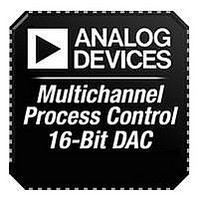AD5755-1ACPZ Analog Devices Inc, AD5755-1ACPZ Datasheet - Page 39

AD5755-1ACPZ
Manufacturer Part Number
AD5755-1ACPZ
Description
16Bit Quad,V/I DAC No Dynamic Power Ctrl
Manufacturer
Analog Devices Inc
Series
-r
Datasheet
1.AD5755-1ACPZ.pdf
(48 pages)
Specifications of AD5755-1ACPZ
Input Channel Type
Serial
Data Interface
3-Wire, Serial
Supply Voltage Range - Digital
2.7V To 5.5V
Digital Ic Case Style
LFCSP
No. Of Pins
64
Operating Temperature Range
-40°C To +105°C
Rohs Compliant
Yes
Resolution (bits)
16bit
Supply Voltage Range - Analog
2.7V To 5.5V
Featured Product
AD5755 / AD5755-1 / AD5757 DACs
Settling Time
11µs
Number Of Bits
16
Number Of Converters
4
Voltage Supply Source
Analog and Digital, Dual ±
Power Dissipation (max)
-
Operating Temperature
-40°C ~ 105°C
Mounting Type
Surface Mount
Package / Case
64-VFQFN Exposed Pad, CSP
Number Of Outputs And Type
4 Current, 4 Voltage
Lead Free Status / Rohs Status
Lead free / RoHS Compliant
Available stocks
Company
Part Number
Manufacturer
Quantity
Price
Company:
Part Number:
AD5755-1ACPZ-REEL7
Manufacturer:
AD
Quantity:
201
DEVICE FEATURES
OUTPUT FAULT
The AD5755-1 is equipped with a FAULT pin, an active low
open-drain output allowing several AD5755-1 devices to be
connected together to one pull-up resistor for global fault
detection. The FAULT pin is forced active by any one of the
following fault scenarios:
•
•
•
•
The V
of the status register are used in conjunction with the FAULT
output to inform the user which one of the fault conditions
caused the FAULT output to be activated.
VOLTAGE OUTPUT SHORT-CIRCUIT PROTECTION
Under normal operation, the voltage output sinks/sources up
to 12 mA and maintains specified operation. The maximum
output current or short-circuit current is programmable by
the user and can be set to 16 mA or 8 mA. If a short circuit is
detected, the FAULT goes low and the relevant short CCT bit
in the status register is set.
DIGITAL OFFSET AND GAIN CONTROL
Each DAC channel has a gain (M) and offset (C) register, which
allow trimming out of the gain and offset errors of the entire
signal chain. Data from the DAC data register is operated on by
a digital multiplier and adder controlled by the contents of the
M and C registers. The calibrated DAC data is then stored in the
DAC input register.
The voltage at I
range due to an open-loop circuit or insufficient power
supply voltage. The internal circuitry that develops the
fault output avoids using a comparator with windowed
limits because this requires an actual output error before
the FAULT output becomes active. Instead, the signal is
generated when the internal amplifier in the output stage
has less than approximately 1 V of remaining drive
capability. Thus, the FAULT output activates slightly before
the compliance limit is reached.
A short is detected on a voltage output pin. The short-
circuit current is limited to 16 mA or 8 mA, which is
programmable by the user. If using the AD5755-1 in
unipolar supply mode, a short-circuit fault may be
generated if the output voltage is below 50 mV.
An interface error is detected due to a PEC failure. See the
Packet Error Checking section.
If the core temperature of the AD5755-1 exceeds
approximately 150°C.
OUT_x
fault, I
OUT_x
OUT_x
fault, PEC error, and over TEMP bits
attempts to rise above the compliance
Rev. A | Page 39 of 48
Although Figure 77 indicates a multiplier and adder for each
channel, there is only one multiplier and one adder in the device,
and they are shared among all four channels. This has
implications for the update speed when several channels are
updated at once (see Table 3).
Each time data is written to the M or C register, the output is
not automatically updated. Instead, the next write to the DAC
channel uses these M and C values to perform a new calibration
and automatically updates the channel.
The output data from the calibration is routed to the DAC input
register. This is then loaded to the DAC as described in the
Theory of Operation section. Both the gain register and the
offset register have 16 bits of resolution. The correct method to
calibrate the gain/offset is to first calibrate out the gain and then
calibrate the offset.
The value (in decimal) that is written to the DAC input register
can be calculated by
where:
D is the code loaded to the DAC channel’s input register.
M is the code in the gain register (default code = 2
C is the code in the offset register (default code = 2
STATUS READBACK DURING A WRITE
The AD5755-1 has the ability to read back the status register
contents during every write sequence. This feature is enabled
via the STATREAD bit in the main control register. This allows
the user to continuously monitor the status register and act
quickly in the case of a fault.
When status readback during a write is enabled, the contents of
the 16-bit status register (see Table 30) are output on the SDO
pin, as shown in Figure 5.
The AD5755-1 powers up with this feature disabled. When this
is enabled, the normal readback feature is not available, except
for the status register. To read back any other register, clear the
STATREAD bit first before following the readback sequence.
STATREAD can be set high again after the register read.
Code
DAC DATA
REGISTER
REGISTER
REGISTER
DACRegiste
M
C
Figure 77. Digital Offset and Gain control
r
=
D
×
(
M
2
16
+
) 1
+
C
REGISTER
−
INPUT
DAC
2
15
AD5755-1
16
15
DAC
– 1).
).
(1)













